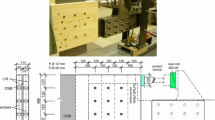Abstract
The effect of friction between the dowel and the surrounding timber was studied for single dowel-type joints. The joints tested were divided into two groups of joints, where the surface of the dowels differed. For the first group, the dowels had a smooth surface and for the second group the dowels had a rough surface. A contact-free measurement technique was used in the experimental investigation. In addition to that, numerical simulations were carried out aimed at predicting the load-bearing capacity of the joints tested as well as estimating the coefficient of friction between the dowel and the surrounding timber.
Important conclusions from this study, which are supported by previous research, are that the load-bearing capacity of single dowel-type joints increases when the surface roughness of the dowel increases. A very small scatter in the results, in terms of the load-displacement behavior, was seen in the tests with rough surface dowels. For the joints with smooth surface dowels, the elastic response as well as the plastic response varied considerably between different tests. The current version of the European timber code EC5 does not explicitly take into account the effect of friction. In order to take the effect into account embedding tests have to be performed in order to be able to consider the benefits of using dowels with rough surface.
Zusammenfassung
Untersucht wurde der Einfluss der Reibung zwischen dem Dübel und dem umgebenden Holz. Zwei verschiedene Verbindungen mit jeweils unterschiedlicher Dübeloberfläche wurden untersucht. In einer Verbindung wurden Dübel mit einer glatten Oberfläche und in der zweiten Verbindung Dübel mit einer rauen Oberfläche verwendet. In der experimentellen Untersuchung wurde ein berührungsloses Messverfahren eingesetzt. Zusätzlich wurden Simulationsrechnungen zur Berechnung der Tragfähigkeit der Verbindungen sowie der Schätzung des Reibungskoeffizienten zwischen Dübel und umgebendem Holz durchgeführt.
Als wichtigstes Ergebnis zeigte sich in Übereinstimmung mit früheren Untersuchungen, dass die Tragfähigkeit einer Stabdübelverbindung mit zunehmender Oberflächenrauhigkeit des Dübels zunimmt. Bei den Versuchen mit rauer Dübeloberfläche wiesen die Kraft-Weg-Diagramme nur eine geringe Streuung auf. Das elastische und plastische Verhalten der Verbindungen mit glatter Dübeloberfläche streute dagegen zwischen den verschiedenen Versuchen beachtlich. In der aktuellen Fassung des Eurocode 5 wird der Einfluss der Reibung nicht explizit berechnet. Um diesen Einfluss zu berücksichtigen, müssen Versuche zur Lochleibungsfestigkeit durchgeführt werden, um den Vorteil der Verwendung von Dübeln mit rauer Oberfläche nutzen zu können.
Similar content being viewed by others
References
ABAQUS Inc (2004) ABAQUS/Standard and ABAQUS/CAE Version 6.5, User Manuals
Aicher S, Gustafsson PJ (ed), Haller P, Petersson H (2002) Fracture mechanics models for strength analysis of timber beams with a hole or a notch – a report of RILEM TC-133. Report TVSM-7134, Lund University, Sweden
Blaß HJ (2003) Joints with dowel-type fasteners. In: Thelandersson S, Larsen HJ (eds) Timber Engineering. Wiley & Sons, Chichester, England, pp 315–331
Daudeville L, Davenne L, Yasumura M (1999) Prediction of the load carrying capacity of bolted timber joints. Wood Sci Technol 33(1):15–29
Davenne L, Daudeville L, Yasumura M (1996) Failure of doweled joints loaded parallel to the grain: experiment and simulation. Proceedings of the CIB W18 Meeting, paper CIB-W18/29-7-8
Dinwoodie JM (2000) Timber: Its nature and behavior. Second edition, E & FN Spon, London
Eurocode 5 (2004) Eurocode 5 – Design of timber structures. EN 1995-1-1:2004(E)
European standard (1993) EN 383:1993 Timber structures – Test methods. Determination of embedding strength and foundation values for dowel type fasteners
Gustafsson PJ (2002) Mean stress approach and initial crack approach. In: Aicher S, Gustafsson PJ (ed) Haller P and Petersson H Fracture mechanics models for strength analysis of timber beams with a hole or a notch – a report of RILEM TC-133. Report TVSM-7134, Lund University, Sweden
Gustafsson PJ (2003) Fracture perpendicular to the grain – structural applications. In: Thelandersson S, Larsen HJ (eds) Timber Engineering. Wiley & Sons, Chichester, England, pp 103–130
Johansen KW (1949) Theory of timber connections. Int Assoc Bridge Struc Eng 9:249–262
Jorissen A (1998) Double shear timber connections with dowel type fasteners, Delft University Press, ISBN 90-407-1783-4
Rodd PD (1973) The analysis of timber joints made with circular dowel connectors. Ph D thesis, University of Sussex, England
Schmid M, Blaß HJ, Frasson RPM (2002) Effect of distances, spacing and number of dowels in a row on the load carrying capacity of connections with dowels failing by splitting. Proceedings of the CIB W18 Meeting, paper CIB-W18/31-9-1, Kyoto, Japan
Serrano E, Enquist B (2005) Contact-free measurement and non-linear finite element analyses of strain distribution along wood adhesive bonds. Holzforschung 59(6):641–646
Serrano E, Gustafsson PJ (2006) Fracture mechanics in timber engineering – Strength analyses of components and joints. Mater Struct 40:87–96
Siem J (1999) Capacity and ductility of dowel connections in timber structures (In Norwegian). Ph.D. thesis, Norwegian University of Science and Technology, 1999:46, Trondheim, Norway
Sjödin J, Serrano E, Enquist B (2006) Contact-free measurements and numerical analyses of the strain distribution in the joint area of steel-to-timber dowel joints. Holz Roh- Werkst 64:497–506
Author information
Authors and Affiliations
Corresponding author
Rights and permissions
About this article
Cite this article
Sjödin, J., Serrano, E. & Enquist, B. An experimental and numerical study of the effect of friction in single dowel joints . Holz Roh Werkst 66, 363–372 (2008). https://doi.org/10.1007/s00107-008-0267-z
Published:
Issue Date:
DOI: https://doi.org/10.1007/s00107-008-0267-z




